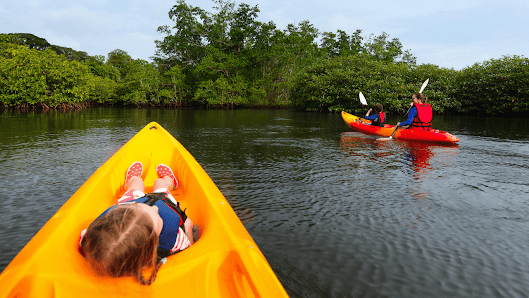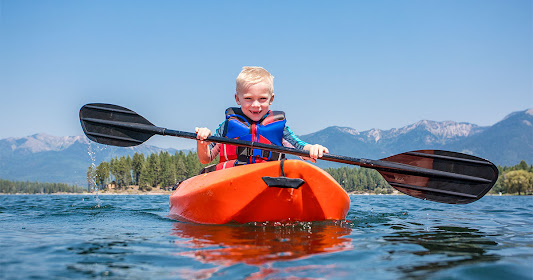For kayaking with children - at what age can you start?
Kayaking trips are becoming increasingly popular. They are an ideal way for active recreation and close contact with nature. But is it possible to go on them with the whole family, together with children? Of course, you can!
Kayaking
can be a great adventure not only for us adults but also for our kids. At this
point, however, parents are asking themselves the first, basic question. How
old should a child be to be taken on a rafting trip? Are there any regulatory
restrictions? Does it depend only on the parent's and the child's desire to
participate in such an activity?
We will try
to answer these questions today.
Child on a canoe trip - under the supervision of an adult and experienced person
A child of any age can go kayaking. There are no regulatory restrictions. The only condition is to ensure his safety. Therefore, every child on a canoe trip should be accompanied by an adult. And one adult should be supervised by only one child.
It's also
good if the adults taking care of the children are already reasonably familiar
with kayaking themselves. They know how to get into the canoe safely, maneuver
it on the river and get past the more difficult spots. Do not decide to go
kayaking with a child, especially a very young one, if you are not confident in
your total control of the kayak or are just learning to do so.
You might be interested in reading - Best Kayaks For Kids.
A child under 3 on a canoe trip - is it a good idea?
If we want to take an infant or toddler under the age of 3 on a canoe trip, we can do so, but at the beginning, however, it is worthwhile to think through a few issues well.
Taking care of a tiny baby is demanding. It needs changing, feeding or preparing a special meal, soothing when it cries, and paying attention to whether it takes something dirty in its mouth. In the conditions of a canoe trip, this is more cumbersome than at home. In addition, you have to watch out if a crawling baby climbs over the side of the canoe. Constantly preoccupied with the child, we distract ourselves from steering the kayak, which can lead to potentially dangerous situations.
It is difficult to fit a life jacket for such a tiny child. If it is too large, the child may slip out of it or the vest will overlap his head, which is very dangerous in case of a capsize. A vest that has a large collar and is sewn from thick material filled with buoyancy foam can also be simply uncomfortable for a young child and restrict his movements. Since a small child does not yet understand the need to put it on, the lack of comfort can be a reason for crying and whining.
Many mothers use special carriers and slings to transport a tiny baby. This is a safe and comfortable way to carry our little one, but not on a canoe trip. In case of a capsize, the baby will be all under the surface of the water. In addition, he may get entangled in the sling, which increases the danger. So we do not recommend using them on a kayak.
Access to medical care on a canoe trip is limited. There should, of course, be a first aid kit with basic medications on each one, but it may not be sufficient in many dangerous situations for a child. If, for example, it turns out that the child is allergic to insect venom and goes into anaphylactic shock after a sting, professional help may not arrive in time.
If we
nevertheless decide to go canoeing with such a young child, let's choose short
day trips, after which we can return to a stationary overnight stay. This way
we will combine rafting with the conveniences that make life easier for young
mothers.
Canoeing with a preschooler
3, 4, 5, 6 years old - this is the perfect time to take your child on a canoe trip for the first time. He is already big enough to sit in a canoe on his own.
The first rafting trip for a preschool child should be short - 1-2 hours so that the child can get used to the canoe, and the parent can check his reactions. If the river trip pleases the child, you can gradually increase the rafting time to several hours. To begin with, however, try to choose routes with plenty of places where the rafting can be completed. Then we will be able to decide on the fly whether we finish earlier or float a bit further. In such places, you can also make a short stop so that your child can get out of the canoe, stretch his legs, and play on the shore.
Once our child has seriously caught the canoeing bug, you can even take him or her on a 2-3 day trip. An additional attraction will then be camping in the open air, lighting a campfire in the evening, or sleeping in a tent.
For the first rafting trip with a child, let's prepare information and interesting facts about the route to be traveled. Preschool children ask a lot of questions. Canoeing is a great opportunity to impart knowledge to them about the river we are going, about the plants and trees growing in the area, and the birds and animals we meet. By drawing attention to the beauty of nature, we thus shape in children an aesthetic sense and respect for nature.
It is also worth showing such children already how an adult maneuvers a canoe and how to move the paddle. When they grow up a bit more, they themselves will be happy to help us paddle.
In addition
to a handful of knowledge, let's also take along a few additional trinkets that
will make the rafting trip more interesting. These can be, for example, rubber
or inflatable floating toys that can be tied to the canoe on a rope and pulled
along.
To go kayaking with a student and a teenager
Children in
the younger grades of elementary school, aged 7-10, are already eager to help
with paddling. They can use smaller paddles, adapted in weight and size to
their abilities. There are also folding paddles that can be stowed in the kayak
if they are not useful.
A child of
this age can easily be taken on a longer trip. The route can also be a little
more difficult than for younger children.
When our
child is in his teens, he needs a lot of contact with his peers. It is then
worth organizing a rafting trip with several families and taking his friends.
This is conducive to deepening friendships and collecting cool memories.
When our
teenager already knows how to paddle and maneuver a canoe, you can let him go
on his own in a single-person canoe. This will be an excellent test of his
abilities. However, always parents or other experienced kayakers should be
nearby.
Finally, it
is worth emphasizing that every child is different, and the parent knows him
best. Therefore, he himself must answer the question of whether he is ready to
take his child on a rafting trip and at what point, whether the child feels
like it, and whether he enjoys this form of leisure activity.




Comments
Post a Comment